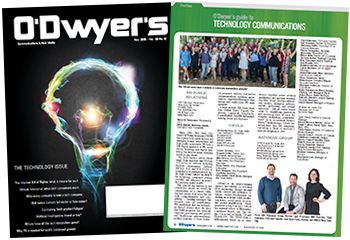 Adam Cormier |
Businesses today are leaning on marketing departments to deliver more than a 30-second television ad. Elevating brand awareness and influencing the customer experience, all while being held accountable for net new revenue, is today’s expectation of marketing departments.
These needs can be fulfilled with the art and science of storytelling.
Helping define the term “story,” Robert McKee and Thomas Gerace, co-authors of Storynomics, Story-Driven Marketing in the Post-Advertising World, surmise that, “the essential core event in all stories ever told in the history of humanity can be expressed in just three words: conflict changes life.”
|
|
Today, screens of all sizes are bombarded with messages striving to propel the audience to action. Messages that aren’t tied to the brand’s story fail. If there’s no brand story, the message had no shot from the get-go.
Unfortunately, in conference rooms around the world, “story” is used interchangeably with things that are not a story, like narratives, journeys and, worst of all, use cases. These things are important to incorporate through the different stages of story to integrate the voice of a customer, but to equate them with the story itself is an unfortunate malpractice.
Human evolution drives us to desire stories. There’s both a physiological and psychological reaction to a well-told story. Naturally, we identify with an empathetic protagonist and go as far as to mirror emotions and actions. Most importantly, we use our storage bank of stories to inform our action/reaction to present and future situations. Stories, regardless of fact or fiction, give us a frame of reference that is the basis for making decisions. In other words, a good brand story naturally compels a trusted buying decision.
How to tell a good brand story?
As brand storytellers, we live in a world of ever-shifting forces. On one side, there is the changing and fractured mix of channels with which to communicate the elements of story. Combining this flux of channels with shrinking time and space demands that we are data-driven, creative and disciplined.
There’s drama in data
Understanding the intended audience requires a deep and ongoing review of data. An effective story touches the needs and desires of the audience. To convert from audience to prospect, the target personas created within the marketing organization must detail not just demographics, but also a rich understanding of the motivations, pressures and objects of desire. As time passes, the trustworthiness of channels ebbs and flows, so data analysis is an always-on commitment. Consistent evaluation of data will help drive the channel mix as it relates to the different stages of the story. From social channels to landing pages to blogs, each and every channel presents an opportunity for content — earned, owned and paid — to be integrated into a storyboard that brings the audience through each story stage.
Creativity differs by channel, audience
A story-driven model ultimately tests the marketing department to break away from a feature/benefit/award theme and think bigger about the brand and its place in the minds of employees, customers, prospects and the community. The challenge posed to the marketing team is to develop an empathetic protagonist out of a thing, not a person. Understanding that audiences are more cynical today than ever before, thanks to years of mistrustful actions from corporations and executives, a story’s power comes from positive emotional ties. With this, creative “character” development is required to achieve a connection. Giving “life” to an inanimate object involves well-crafted words and dynamic imagery. Instead of the 30-second television ad as the primary channel, today’s marketer has the creative freedom to reach audiences with a near infinite mix of pairing words and imagery by communications channel. A marketer today can take an idea, integrate it within the brand story, and deliver a truly customized message to a specific target where, when and how the target desires to receive that message.
Disciplined to keep the story vision
Science and the history of humankind proves that a story is a foundational element to how we react and respond to the actions and environment around us. Changing to a story-driven model is a cultural shift within an organization, but the benefit is a sustained emotional connection with customers and employees. This requires discipline among marketing, sales and leadership to stay the course. Like great TV shows that keep audiences engaged season to season, a disciplined team keeps the story vision through the many arcs, twists and turns as the business evolves.
The most compelling success stories in business are aptly named and connect with us on an emotional level.
To conclude with an additional passage from Storynomics, “The mind builds stories to bridge the gap between itself and the universe, between itself and the past, present, and future. Story form imposes order on chaos; it penetrates the enigma of the seems to express the cause and effect of the is; it unifies events to bring meaning out of meaninglessness. Knowledge expressed in story form gathers other human beings around its themes, uniting communities and building cultures.”
For B2B marketers at technology companies, a story-driven approach solves many challenges, from product/solution adoption and awareness to customer experience. “Speeds and feeds” do not make a story. Bringing life to a brand that is empathetic, humble and understanding of the audiences’ object of desire will impact results dramatically. Start with understanding your audience while taking a critical look at the protagonist (the business). Audit existing content by its core value. If it does not fit a binary problem/solution construct, it holds no value in the brand story. From here, assess the gaps, set the long-term vision and storyboard the plot twists to success.
***
Adam Cormier is vice president at PAN Communications.



 Laura Anderson, who rose to VP/GM of global communications and events in a nearly 20 year stint at Intel, will take on the Americas technology chair at Burson following the completion of the BCW and H+K merger on July 1.
Laura Anderson, who rose to VP/GM of global communications and events in a nearly 20 year stint at Intel, will take on the Americas technology chair at Burson following the completion of the BCW and H+K merger on July 1. WE Communications has partnered with ROKK Solutions to form the WE ROKK AI service.
WE Communications has partnered with ROKK Solutions to form the WE ROKK AI service. In the dynamic world of modern business, effective communication is a pivotal tool for success across various industries. At Communications Strategy Group (CSG®), our expertise in embracing innovation in communication extends beyond traditional marketing strategies, paving the way for transformative industry-specific solutions.
In the dynamic world of modern business, effective communication is a pivotal tool for success across various industries. At Communications Strategy Group (CSG®), our expertise in embracing innovation in communication extends beyond traditional marketing strategies, paving the way for transformative industry-specific solutions. There are two types of tech PR professionals. Which one are you? And are C-suite executives making that decision for you?
There are two types of tech PR professionals. Which one are you? And are C-suite executives making that decision for you? While there’s an impulse to grab reporters’ attention with the newest industry-transforming tech product or service, a back-to-basics approach focused on telling the right stories to the right people is a far more successful way to ensure your technology campaign breaks through the clutter of today’s crowded tech landscape.
While there’s an impulse to grab reporters’ attention with the newest industry-transforming tech product or service, a back-to-basics approach focused on telling the right stories to the right people is a far more successful way to ensure your technology campaign breaks through the clutter of today’s crowded tech landscape.


 Have a comment? Send it to
Have a comment? Send it to 
No comments have been submitted for this story yet.